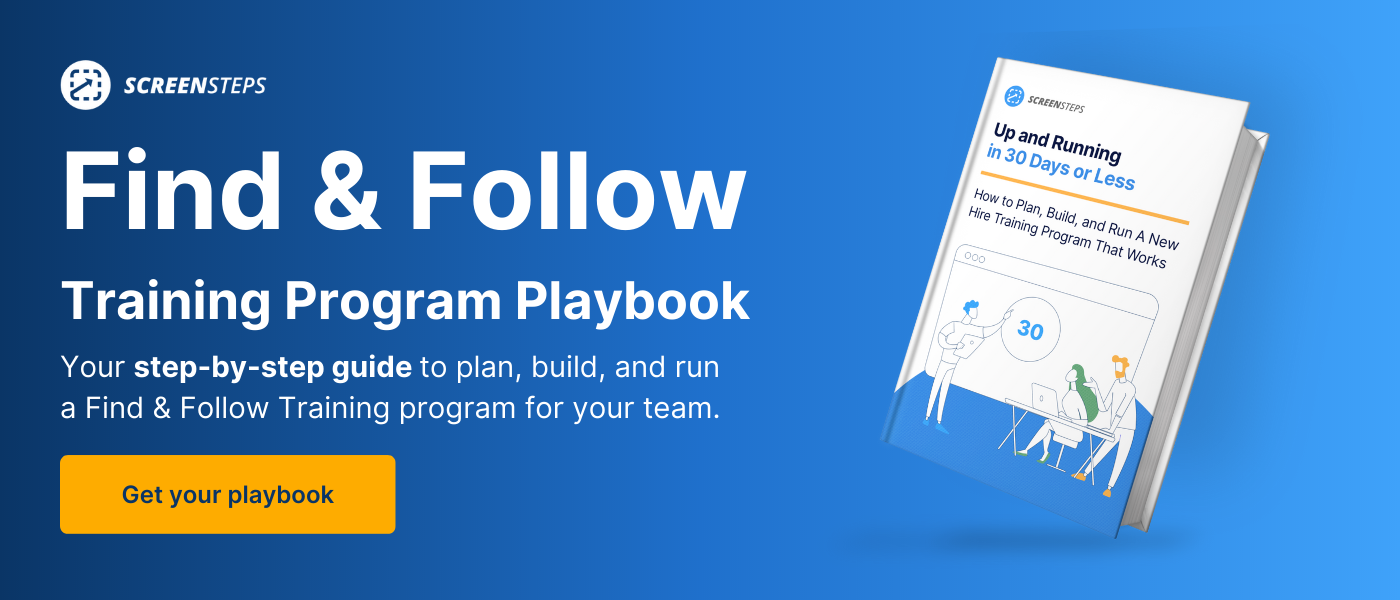How Find & Follow Differs From Traditional Employee Training [VIDEO]
Over the past nine years of working in the content management and training industry, I’ve been surprised at how little employee training has changed.
Training programs often follow the same pattern as your high school lessons: lectures, PowerPoints, and quizzes. The problem is those training approaches are time-consuming and don’t always prepare employees for the jobs they were hired to do.
This is why we developed the Find & Follow Training Framework at ScreenSteps, a knowledge base and training software company.
Chances are you've either heard of or used elements of the Find & Follow Training Framework before. The difference is how the training exercises are paired together. By diligently adhering to this framework, you can create a training curriculum that helps you train employees in 30 days or less.
So, what makes Find & Follow different from traditional employee training approaches?
Watch this 4-minute video for a quick side-by-side on how the Find & Follow Training Framework compares to traditional employee training approaches. We'll examine the approach, intent, and outcome of both training frameworks to see how they compare.
1. Approach
What is different about the training approaches?
Traditional employee training
When you imagine employee training, what do you think of? Most likely, it aligns with a traditional employee training program.
The training takes place in a classroom or virtually over Zoom. The trainer spends most of the training lecturing on everything the new hires need to know for their jobs.
This could include PowerPoint presentations. Each slide contains tons of text and screenshots — which employees are expected to memorize.
Periodically, the trainer asks if anyone has questions, but typically the answer is a not very enthusiastic “no.”
Throughout training and/or at the end of the training, you have employees take an assessment to test if they learned everything they needed to in training.
Find & Follow
The Find & Follow Training Framework is broken down into three parts that look like this:
Part 1: Teach foundational explanations
Learners either listen to a 10-20-minute foundational training presentation or take a short 10-minute self-paced course.
This is an introduction to a topic. It provides background information and context so that employees understand the big picture of the tasks they will perform.
Part 2: Train employees how to use your digital guides
Next, they learn how to read the digital guides. These are your job aids, step-by-step procedures, checklists, call flows, etc.
What do words in italics mean? What do highlighted boxes indicate? This is your opportunity to teach employees how to read the guide so they are able to follow it in real time.
Part 3: Practice real-life scenarios
The third and final part of Find & Follow is the section that will take up the bulk of the time.
In this part, your employees role-play real-life scenarios they will encounter on the job. Your employees follow the digital guides to practice these scenarios. You are replicating precisely what they will do on the job once training is completed.
You repeat the 3-part training for each topic or area of learning.
2. Intent
One of the most definitive differences between traditional employee training and Find & Follow is the intent of the different training programs.
Traditional employee training
The intent of the traditional employee training approach is for employees to KNOW something.
It heavily relies on learners to memorize everything. Employees are expected to remember everything they were told and saw (even if they only saw it on a text-heavy slide for a few minutes).
This puts a lot of pressure on the employee and doesn't leave room for human error. After all, it's human nature to forget something or draw a blank every once in a while.
Find & Follow
Whereas traditional training approaches prepare employees to KNOW something, Find & Follow prepares employees to know and be able to DO something.
What do I mean by "do" something? It means that your employees have sufficient knowledge and experience to complete a task. This doesn't mean they need everything memorized.
Find & Follow leverages knowledge base software to train and support employees so that they can find the job aids they need, follow the guide, and complete tasks.
3. Outcome
What are the outcomes when you use these different training programs? How is employee performance post-training?
Traditional employee training
Ultimately, employees memorize everything they need to know for their jobs. However, that process can take a long time depending on if you have 10 or hundreds of procedures to learn.
The process following training for employees to reach proficiency typically takes a long time. While training may only last 1-3 months, employees may not become proficient at their jobs for 6-12 months.
Being proficient at their jobs means they are able to handle any task without needing to ask a coworker or supervisor for help.
When it takes months to achieve proficiency, it is often frustrating for both supervisors and employees.
Find & Follow
After training is complete, employees can jump into their jobs with both feet. Because your employees practiced real scenarios during training, they have real-life experience.
They have completed these procedures many times already, so they are ready to work independently.
Achieve employee proficiency in 30 days or less
With the Find & Follow Training Framework, you prepare your employees to be more knowledgeable, consistent, and efficient in 30 days or less.
When you pair Find & Follow training with a ScreenSteps knowledge base, you provide your team with a powerful tool that makes it easy to create, store, and share your guides.
Employees can find the guides they need in as few as two clicks.
Learn more about Find & Follow. Download our free eBook on how you can create and run a Find & Follow program.
![How Find & Follow Differs From Traditional Employee Training [VIDEO]](https://blog.screensteps.com/hubfs/Find%20%26%20Follow%20vs%20Traditional%20Employee%20Training.jpg)

.png)

